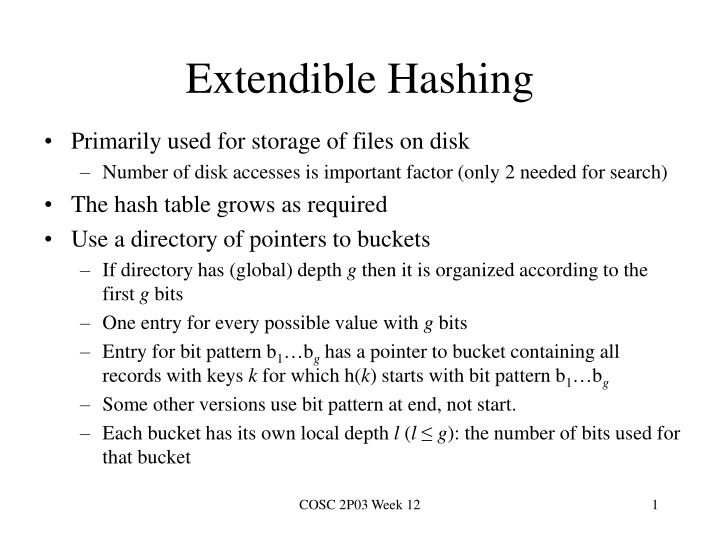
Efficient File Storage Using Extendible Hashing
Learn how extendible hashing facilitates efficient file storage on disks by minimizing the number of disk accesses required for searching. This method dynamically grows the hash table as needed and utilizes a directory of pointers to buckets, organized based on the first few bits of keys. Explore examples, directory and bucket structures, bucket splits, and understand how multiple splits are handled to optimize storage.
Download Presentation

Please find below an Image/Link to download the presentation.
The content on the website is provided AS IS for your information and personal use only. It may not be sold, licensed, or shared on other websites without obtaining consent from the author. If you encounter any issues during the download, it is possible that the publisher has removed the file from their server.
You are allowed to download the files provided on this website for personal or commercial use, subject to the condition that they are used lawfully. All files are the property of their respective owners.
The content on the website is provided AS IS for your information and personal use only. It may not be sold, licensed, or shared on other websites without obtaining consent from the author.
E N D
Presentation Transcript
Extendible Hashing Primarily used for storage of files on disk Number of disk accesses is important factor (only 2 needed for search) The hash table grows as required Use a directory of pointers to buckets If directory has (global) depth g then it is organized according to the first g bits One entry for every possible value with g bits Entry for bit pattern b1 bghas a pointer to bucket containing all records with keys k for which h(k) starts with bit pattern b1 bg Some other versions use bit pattern at end, not start. Each bucket has its own local depth l (l g): the number of bits used for that bucket COSC 2P03 Week 12 1
Extendible Hashing Example Suppose that g=2 and bucket size = 4. Suppose that we have records with these keys and hash function h(key) = key mod 64: key 288 8 1064 120 148 204 641 700 258 1586 44 h(key) = key mod 64 32 8 40 56 20 12 1 60 2 50 44 bit pattern 100000 001000 101000 111000 010100 001100 000001 111100 000010 110010 101010 COSC 2P03 Week 12 2
Extendible Hashing Example directory and bucket structure g=2 00 01 10 11 l = 2 l = 2 l = 2 l = 2 8 148 288 120 204 1064 700 641 44 1586 258 COSC 2P03 Week 12 3
Bucket and directory split Insert 68 68 mod 64 = 4 = 000100 g=3 000 001 010 011 100 101 110 111 l = 3 l = 3 l = 2 l = 2 l = 2 641 8 148 288 120 258 204 1064 700 68 44 1586 COSC 2P03 Week 12 4
Bucket split no directory split Insert 48 and 575 48 mod 64 = 48 = 110000 575 mod 64 = 63 = 111111 g=3 000 001 010 011 100 101 110 111 l = 3 l = 3 l = 2 l = 2 l = 3 l = 3 641 8 148 288 1586 120 258 204 1064 48 700 68 44 575 COSC 2P03 Week 12 5
Multiple splits Insert 16, 18, 22, 23 16 mod 64 = 16 = 010000 18 mod 64 = 18 = 010010 22 mod 64 = 22 = 010110 23 mod 64 = 23 = 010111 010 011 l = 3 l = 3 Setting l=3 gives this intermediate (partial) picture 148 16 Continue to next page 18 22 23 COSC 2P03 Week 12 6
Multiple splits, continued Setting l=4 (and thus g=4) gives this final result g=4 0000 0001 0010 0011 0100 0101 0110 0111 1000 1001 1010 1011 1100 1101 1110 1111 l = 3 l = 3 l = 4 l = 4 l = 3 l = 2 l = 3 l = 3 641 8 16 148 288 1586 120 258 204 18 22 1064 48 700 68 23 44 575 COSC 2P03 Week 12 7
